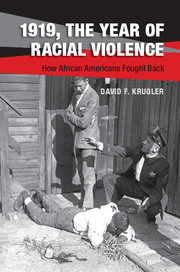Book contents
- Frontmatter
- Dedication
- Contents
- Acknowledgments
- Source Abbreviations and Usage Note
- Introduction
- 1 World War I and the New Negro Movement
- 2 “We Return Fighting”
- 3 Fighting a Mob in Uniform
- 4 Blood in the Streets
- 5 Armed Resistance to the Courthouse Mobs
- 6 Armed Resistance to Economic Exploitation in Arkansas, Indiana, and Louisiana
- 7 “It Is My Only Protection”
- 8 The Fight for Justice
- 9 The Fight for Justice
- 10 Fighting Judge Lynch
- Conclusion
- Bibliography
- Index
- References
1 - World War I and the New Negro Movement
Published online by Cambridge University Press: 05 December 2014
- Frontmatter
- Dedication
- Contents
- Acknowledgments
- Source Abbreviations and Usage Note
- Introduction
- 1 World War I and the New Negro Movement
- 2 “We Return Fighting”
- 3 Fighting a Mob in Uniform
- 4 Blood in the Streets
- 5 Armed Resistance to the Courthouse Mobs
- 6 Armed Resistance to Economic Exploitation in Arkansas, Indiana, and Louisiana
- 7 “It Is My Only Protection”
- 8 The Fight for Justice
- 9 The Fight for Justice
- 10 Fighting Judge Lynch
- Conclusion
- Bibliography
- Index
- References
Summary
“The war to end all wars.” For a brief time, Americans used this name to refer to the conflict that broke out in Europe in 1914, the war now known, of course, as World War I. The name is optimistic, confident, boundless in its ambition; and, given the global violence that engulfed the twentieth century, not a little naïve. In 1917, however, the war to end all wars articulated the special purpose President Woodrow Wilson stamped upon America’s formal entry into the conflict. “The world must be made safe for democracy,” he declaimed in his request to Congress for a declaration of war against Germany. For Wilson, this mission meant using an Allied victory to create an international organization of collective security, the League of Nations. Led by the United States and other democratic nations, the league would, Wilson hoped, deter aggression, promote the spread of democracy, and ultimately render war obsolete.
To understand why and how African Americans fought a three-front war against mob violence during 1919, it is necessary to examine their responses to Wilson’s mission. It was not an issue that preoccupied the president. Certainly Wilson hoped the nation’s black citizens would support the war, but the problem of asking one group of Americans to fight abroad for the democracy denied to them at home did not unsettle Wilson, who was much more concerned with promoting patriotism to America’s vast population of immigrants. For African Americans, Wilson’s call to war offered an opportunity to redress America’s deficiencies. For doing their part to make the world safe for democracy, blacks expected restoration of voting rights in the South, an end to lynching and mob violence, and the dismantling of racial segregation.
- Type
- Chapter
- Information
- 1919, The Year of Racial ViolenceHow African Americans Fought Back, pp. 15 - 34Publisher: Cambridge University PressPrint publication year: 2014



